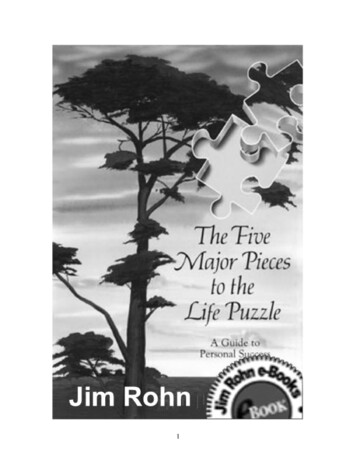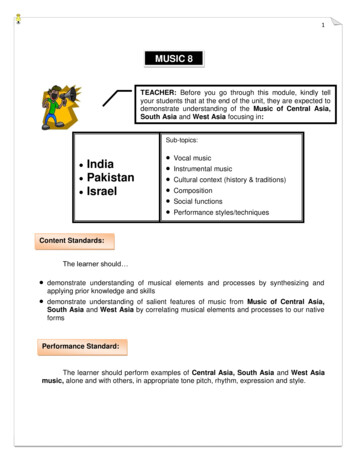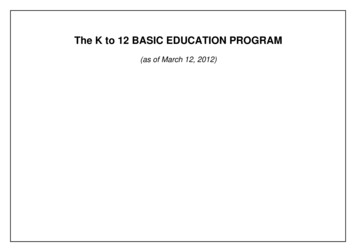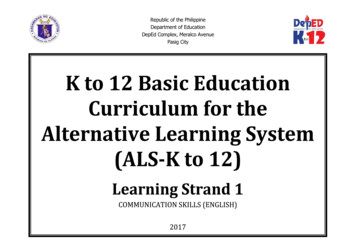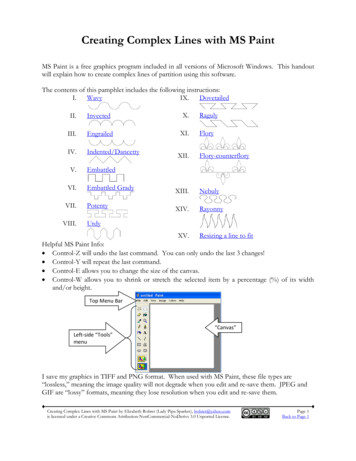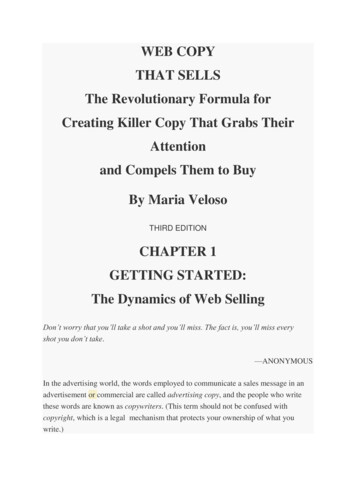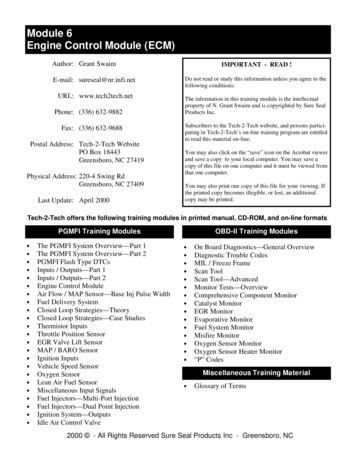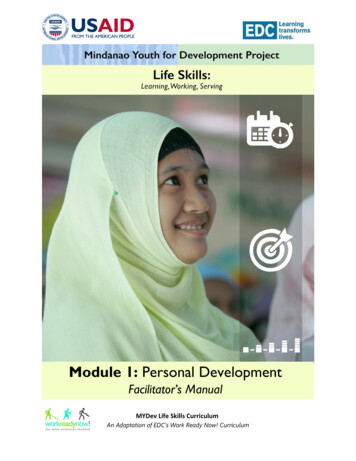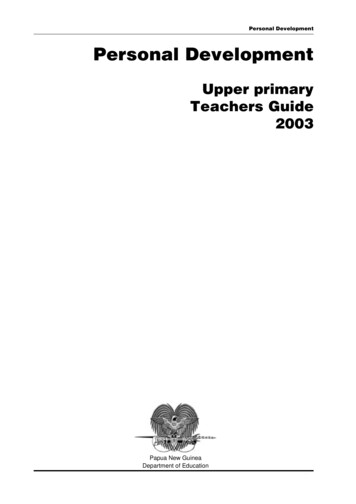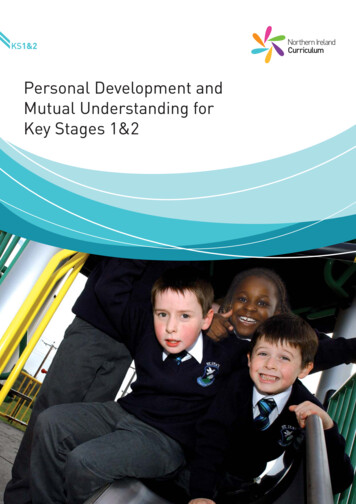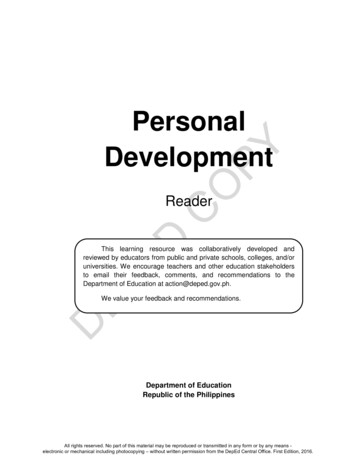
Transcription
COPYPersonalDevelopmentDReaderEPEThis learning resource was collaboratively developed andreviewed by educators from public and private schools, colleges, and/oruniversities. We encourage teachers and other education stakeholdersto email their feedback, comments, and recommendations to theDepartment of Education at action@deped.gov.ph.DWe value your feedback and recommendations.Department of EducationRepublic of the PhilippinesAll rights reserved. No part of this material may be reproduced or transmitted in any form or by any means electronic or mechanical including photocopying – without written permission from the DepEd Central Office. First Edition, 2016.
Personal DevelopmentReaderFirst Edition 2016Republic Act 8293. Section 176 states that: No copyright shall subsist in any workof the Government of the Philippines. However, prior approval of the government agency oroffice wherein the work is created shall be necessary for exploitation of such work for profit.Such agency or office may, among other things, impose as a condition the payment ofroyalties.PYBorrowed materials (i.e., songs, stories, poems, pictures, photos, brand names,trademarks, etc.) included in this learning resource are owned by their respective copyrightholders. DepEd is represented by the Filipinas Copyright Licensing Society (FILCOLS), Inc.in seeking permission to use these materials from their respective copyright owners. Allmeans have been exhausted in seeking permission to use these materials. The publisherand authors do not represent nor claim ownership over themCOOnly institutions and companies which have entered an agreement with FILCOLSand only within the agreed framework may copy from this Reader. Those who have notentered in an agreement with FILCOLS must, if they wish to copy, contact the publishers andauthors directly.Authors and publishers may email or contact FILCOLS at filcols@gmail.com or (02)435-5258, respectively.DPublished by the Department of EducationSecretary: Br. Armin A. Luistro FSCUndersecretary: Dina S. Ocampo, PhDEPEDevelopment Team of the Personal Development ReaderDr. Barbara Wong-Fernandez, RGCEstesa Xaris Que-Legaspi, RGCCarolyn C. Quiba, RGCMae R. Rafanan, RGCZisa Velasquez-Garcia, RGCCover Artist:Layout Artist:Sharlyn SanclariaJay L. MabutiDManagement Team of the Personal Development ReaderBureau of Curriculum DevelopmentBureau of Learning ResourcesPrinted in the Philippines by Sunshine Interlinks Publishing House, Inc.3F Maine City Tower, 236 Tomas Morato Avenue,Brgy. South Triangle, Quezon CityDepartment of Education-Bureau of Learning Resources (DepEd-BLR)Office Address: Ground Floor Bonifacio Building, DepEd ComplexMeralco Avenue, Pasig City, Philippines 1600Telefax:(02) 634-1054 or 634-1072E-mail Address: depedblr@gmail.comiiAll rights reserved. No part of this material may be reproduced or transmitted in any form or by any means electronic or mechanical including photocopying – without written permission from the DepEd Central Office. First Edition, 2016.
TABLE OF CONTENTSTABLE OF CONTENTS . iiiORIENTATION to PERSONAL DEVELOPMENT . vDCOPYUnit 1: Self-Development .1MODULE 1: Knowing and Understanding Oneself during Middle and Late Adolescence . 1Reading: SELF-CONCEPT . 2Reading: PERSONAL EFFECTIVENESS . 3Reading: BUILD ON YOUR STRENGTHS AND WORK ON YOUR WEAKNESSES . 5Reading: Story: YOU NEED TO TAKE CHARGE OF YOUR FUTURE . 6Reading: THE POWER OF JOURNAL WRITING . 7MODULE 2: Developing the Whole Person . 8Reading: ASPECTS OF THE SELF . 9Reading: THE STORY OF THE TWO WOLVES. 15Reading: THE POWER TRIAD: THOUGHTS, FEELINGS AND ACTIONS . 16MODULE 3: Developmental Stages in Middle and Late Adolescence . 17Reading: DEVELOPMENTAL STAGES . 18Reading: HAVIGHURST S DEVELOPMENTAL TASKS DURING THE LIFE SPAN . 19Reading: LIVING MINDFULLY . 22Reading: THE PASSAGE TO ADULTHOOD: CHALLENGES OF LATE ADOLESCENCE . 24MODULE 4: The Challenges of Middle and Late Adolescence . 24Reading: ENCOURAGEMENT 101: The Courage to Be Imperfect . 25Reading: THE POWER OF PERSONAL DECLARATIONS . 26Reading: BEING HAPPY . 27DEPEUnit 2: Aspects of Personal Development . 29MODULE 5: Coping with Stress in Middle and Late Adolescence . 29Reading: STRESS MANAGEMENT. 29Reading: STRESS RESPONSE . 33Reading: KEEP STRESS UNDER CONTROL . 33Reading: BRAINPOWER: COMPLEX ORGAN CONTROLS YOUREVERY THOUGHT AND MOVE . 36MODULE 6: The Powers of the Mind . 36Reading: THE DOMINANT SIDE OF THE BRAIN . 39Reading: RESEARCH STUDY “The Brain’s Left And Right Sides Seem To Work TogetherBetter In Mathematically Gifted Middle-School Youth” . 39Reading: YOU CAN GROW YOUR INTELLIGENCE . 42Reading: THE MYTH OF MICHAEL JORDAN . 44Reading: CHANGE YOUR MIND ABOUT MENTAL HEALTH . 45MODULE 7: Mental Health and Well-Being in Middle and Late Adolescence . 45Reading: SELF ESTEEM AND BODY ESTEEM . 47Reading: SUPPORT STRATEGIES/COMMUNITY MENTAL HEALTH RESOURCES. 49Reading: HELP HOW-TO’S. 50Reading: HEALTHY EATING AND MENTAL HEALTH . 51Reading: EMOTIONAL INTELLIGENCE . 54iiiAll rights reserved. No part of this material may be reproduced or transmitted in any form or by any means electronic or mechanical including photocopying – without written permission from the DepEd Central Office. First Edition, 2016.
MODULE 8: Emotional Intelligence . 54Reading: TYPES OF RESPONSES . 57DCOPYUnit III: Building and Maintaining Relationships . 60MODULE 9: Personal Relationships . 60Reading: WHAT DO WE MEAN BY PERSONAL RELATIONSHIPS? . 61Reading: A RESEARCH STUDY ON RELATIONSHIPS . 61Reading: WHY PERSONAL RELATIONSHIPS ARE IMPORTANT . 62Reading: 25 MOST COMMON RELATIONSHIP PROBLEMS . 63Reading: NURTURE YOUR RELATIONSHIPS. 67Reading: TEN RULES FOR FINDING LOVE AND CREATING LONG-LASTING,AUTHENTIC RELATIONSHIPS . 69Reading: HEALTHY RELATIONSHIPS ITEMS TEST 70Reading: BASIC RIGHTS IN A RELATIONSHIP. 76Reading: HOW CULTURE SHAPES MANY ASPECTS OF ADOLESCENT DEVELOPMENT . 77MODULE 10: Social Relationships in Middle and Late Adolescence . 77Reading: TEENAGERS WHO JOIN YOUTH GROUPS AND OTHER CLUBS ARE HAPPIERAND LESS LIKELY TO DRINK. 78Reading: COMMUNITY ACTIVITY: GET INVOLVED . 79Reading: LESSONS ON LEADERSHIP AND MEMBERSHIP FROM FABLES . 81Reading: SERVANT LEADERSHIP . 83MODULE 11: Family Structures and Legacies . 85Reading: FAMILY STRUCTURE . 87Reading: INSPIRING STORIES OF FAMILIES . 89Reading: FAMILY LEGACIES . 93DEPEUnit IV: Career Development . 99MODULE 12: Persons and Careers. 99Reading: TEN MYTHS ABOUT CAREER PLANNING BUSTED! . 99Reading: CAREER CONCEPTS . 103Reading: WHAT INFLUENCES YOUR CAREER CHOICE? . 104Reading: SUPER’S CAREER DEVELOPMENT THEORY . 106Reading: HOW TO CHOOSE A MAJOR AND A JOB PATH USING CAREER CLUSTERS . 118MODULE 13: Career Pathways . 122Reading: WORK/OCCUPATIONAL ENVIRONMENTS AND INTERESTS . 123Reading: YOUR PERSONAL MISSION STATEMENT: YOU’RE NEVER TOO YOUNG TOCLARIFY YOUR LIFE GOALS AND ASPIRATIONS . 130REFERENCES . 132ivAll rights reserved. No part of this material may be reproduced or transmitted in any form or by any means electronic or mechanical including photocopying – without written permission from the DepEd Central Office. First Edition, 2016.
ORIENTATION to PERSONAL DEVELOPMENTTo the Student of Personal Development:COURSE CONTENT:COPYWelcome to this course, PERSONAL DEVELOPMENT, or PERDEV for short.This is a very interesting course, and can become the most personally rewarding foryou, because the subject matter for this course is YOU!As a new senior high school student, you have now entered a neweducational level, as well as a new psychological and social level, called the middleand late adolescence. You may feel that you are no longer the rapidly growing andawkward teenager, but you also feel you are not quite ready to call yourself a matureadult either.This course shall make you take a deeper look at yourself and analyze yourdevelopmental changes, your skills and traits which can help you meet the varioustasks that you must undertake at this point in your life. It shall provide you with sometechniques to meet stress and other mental health issues with one’s strengths andcoping powers. The course shall also give you the chance to analyze yourrelationships with your family, friends and significant others. Finally, the PERDEVcourse shall help you take stock of where you are in your career development andhow to get to where you want to be.EPEDThere are 4 units in PERDEV, as follows:Unit 1 – Self-DevelopmentUnit 2 – Aspects of Personal DevelopmentUnit 3 – Building and Maintaining RelationshipsUnit 4 – Career DevelopmentThere will be several modules under each unit, to be taken up in severalclass sessions, each of which addresses a key concern in personal development.COURSE METHOD:DPERDEV uses the experiential learning approach, wherein you as a studentwill participate in activities in class to explore specific themes in your development.You will interact with your classmates, do projects with them, discuss various topics,and share your own thoughts, feelings and experiences. You will also makepersonal reflections and write them down. In this manner of self-refection andsharing, you shall help reveal and articulate relevant concepts, theories, and tools indifferent areas of your life.YOUR TEACHER:Your teacher is the guide and facilitator of this course. He/she shall lead theactivities by giving instructions and supervising the procedures. However, since thesubject matter is yourself, the success of the modules depends on the participationand cooperation of you and your classmates.vAll rights reserved. No part of this material may be reproduced or transmitted in any form or by any means electronic or mechanical including photocopying – without written permission from the DepEd Central Office. First Edition, 2016.
MATERIALS FOR PERDEV:This Reader for Students contains the Activity Sheets that you will be usingfor the various modules. Bring this Reader during every session since this will beneeded in most activities. The Reader also has Readings which provide relevant,valuable, and appropriate additional information for the topic at hand. These are onlysamples of informational material. You are encouraged to look for more informationin your Library or by surfing the Internet.REQUIREMENTS FOR PERDEV:COPYYou should have a journal or notebook for PERDEV, in which you will writeyour reflections, insights, comments and opinions. You should also have a portfoliofor PERDEV, which may be a large brown or plastic envelope, a clear book, or anenvelope bag. This is where you will store all the reflections, research outputs,journal entries, survey questionnaires, and other written materials and artwork whichyou do as class work, seatwork, or homework for PERDEV.At the end of each unit, your teacher shall collect your portfolio and give youa grade based on the completeness and quality of your work, your class attendanceand participation, and other special requirements that you agree on in the beginningof the semester.ASSESSMENT AND GRADING SYSTEM:EPEDAssessment of PERDEV shall be through the use of rubrics. A rubric refersto a scoring guide used to evaluate the quality of your outputs, whether doneindividually or in a group. There are 8 portfolio output requirements for every unit ofthe course, with a maximum of 16 points per output, and a maximum of 16 points forattendance per unit. The maximum number of points you can obtain for the unit (orthe quarter) is 144 points, and the number of points shall be converted to gradeequivalents as eDPoints128-144111-12794-11077-9360-76Below 60viAll rights reserved. No part of this material may be reproduced or transmitted in any form or by any means electronic or mechanical including photocopying – without written permission from the DepEd Central Office. First Edition, 2016.
Unit 1: Self-DevelopmentMODULE 1:Knowing and Understanding Oneself during Middleand Late AdolescenceBig Question: How can understanding yourself pave the way to selfacceptance and better relationship with others?PYObjectives:COAt the end of this module, you will be able to:1. explain that knowing yourself can make you accept your strengths andlimitations and dealing with others better;2. share your unique characteristics, habits and experiences; and,3. start and maintain a journal.Activity: SELF-CONCEPT INVENTORYTake a look at your own self-concept and answer the following self-conceptinventory in your journal. Give yourself a rating using the scale: 0 very weak;1 weak; 2 somewhat weak or somewhat strong; 3 strong; 4 very strongDEPED1. I have strong sex appeal.2. I am proud of my physical figure.3. I am physically attractive and beautiful/handsome.4. I exude with charm and poise.5. I am easy to get along with.6. I can adjust to different people and different situations.7. I am approachable; other people are at ease and comfortable with me.8. I am lovable and easy to love.9. I am a fast learner, can understand with one instruction.10. I am intelligent.11. I have special talents and abilities.12. I can easily analyze situations and make right judgments.13. I can be trusted in any transaction.14. I have a clean conscience and carry no guilty feeling.15. I have integrity and good reputation.16. My friends and classmates can look up to me as a model worth emulating.17. I can express my ideas without difficulty.18. I talk in a persuasive manner that I can easily get people to accept what Isay.19. I can express my ideas in writing without difficulty.20. I am a good listener.21. I am emotionally stable and not easily rattled when faced with trouble.22. I am logical and rational in my outlook and decisions.23. I feel and act with confidence.24. I am a mature person.1All rights reserved. No part of this material may be reproduced or transmitted in any form or by any means electronic or mechanical including photocopying – without written permission from the DepEd Central Office. First Edition, 2016.
Scoring: Copy this table in your journal. Write your score opposite each number andget the subtotal.Human total:PYPhysical appeal1234Subtotal:Character13141516Subtotal:COHow do you perceive yourself?EPEDLook at the results of your self-concept inventory and answer the followingquestions.1. In what areas do you consider yourself strong (with score 14-16 orsomewhat weak (score of 10-13) and very weak (below 10).2. Are there qualities you consider as your weakness but other people consideras your strength? What are these? Check with a partner.Example: A lady can say “I m ugly” yet other consider her very charming. Orconversely, one can have the illusion of saying “I am very intelligent or competent”when most of his ideas sound unreasonable or illogical to most of the people.There is indeed a big difference between what you see in yourself (real self-image)and what is projected in the eyes of the others (your social image).3. How realistic is your self- image?4. To what extent does it reflect your real self?DSource: Roldan, Amelia S. (2003). On Becoming a Winner: A Workbook on PersonalityDevelopment and Character Building. AR Skills Development and Management Services(SDMS), Paranaque City, Metro Manila.Reading: SELF-CONCEPTImagine yourself looking into a mirror. What do you see? Do you see yourideal self or your actual self? Your ideal self is the self that you aspire to be. It is theone that you hope will possess characteristics similar to that of a mentor or someother worldly figure. Your actual self, however, is the one that you actually see. It isthe self that has characteristics that you were nurtured or, in some cases, born tohave.The actual self and the ideal self are two broad categories of self-concept.Self-concept refers to your awareness of yourself. It is the construct that negotiatesthese two selves. In other words, it connotes first the identification of the ideal self asseparate from others, and second, it encompasses all the behaviors evaluated in theactual self that you engage in to reach the ideal self.2All rights reserved. No part of this material may be reproduced or transmitted in any form or by any means electronic or mechanical including photocopying – without written permission from the DepEd Central Office. First Edition, 2016.
COPYThe actual self is built on self-knowledge. Self-knowledge is derived fromsocial interactions that provide insight into how others react to you. The actual self iswho we actually are. It is how we think, how we feel, look, and act. The actual selfcan be seen by others, but because we have no way of truly knowing how othersview us, the actual self is our self-image.The ideal self, on the other hand, is how we want to be. It is an idealizedimage that we have developed over time, based on what we have learned andexperienced. The ideal self could include components of what our parents havetaught us, what we admire in others, what our society promotes, and what we think isin our best interest.There is negotiation that exists between the two selves which is complexbecause there are numerous exchanges between the ideal and actual self. Theseexchanges are exemplified in social roles that are adjusted and re-adjusted, and arederived from outcomes of social interactions from infant to adult development.Alignment is important. If the way that I am (the actual self) is aligned with the waythat I want to be (the ideal self), then I will feel a sense of mental well-being or peaceof mind. If the way that I am is not aligned with how I want to be, the incongruence,or lack of alignment, will result in mental distress or anxiety. The greater the level ofincongruence between the ideal self and real self, the greater the level of resultingdistress. Personal development modules ultimate aim is greater self-knowledge thatwill lead to higher alignment between these two personality domains.DSource: efinition-lesson-quiz.htmlPortfolio Output No. 1 – Talent/Variety Show PresentationEPEYour group shall have a presentation in front of the class. The leaders ofeach group (including yours) shall rate your group based on the following criteria:originality (4 points), creativity/resourcefulness (4 points), teamwork (4 points), andaudience impact (4 points), for a maximum of 16 points. Compute the average ofratings for your group and write this average rating for your presentation in yourjournal. Write about your experience as a group leader/member in this activity.DReading: PERSONAL EFFECTIVENESSPersonal effectiveness means making use of all the personal resources –talents, skills, energy and time, to enable you to achieve life goals.Your knowledge of yourself and how you manage yourself impacts directly onyour personal effectiveness. Being self-aware, making the most of your strengths,learning new skills and techniques and behavioral flexibility are all keys to improvingyour personal performance.Our personal effectiveness depends on our innate characteristics – talent andexperience accumulated in the process of personal development. Talents first areneeded to be identified and then developed to be used in a particular subject area(science, literature, sports, politics, etc.).Experience includes knowledge and skills that we acquire in the process ofcognitive and practical activities.3All rights reserved. No part of this material may be reproduced or transmitted in any form or by any means electronic or mechanical including photocopying – without written permission from the DepEd Central Office. First Edition, 2016.
DEPEDCOPYKnowledge is required for setting goals, defining an action plan to achievethem and risk assessment.Skills also determine whether real actions are performed in accordance withthe plan. If the same ability is used many times in the same situation, then itbecomes a habit that runs automatically, subconsciously. Here are some skills thatwill greatly increase the efficiency of any person who owns them:1. Determination. It allows you to focus only on achieving a specific goalwithout being distracted by less important things or spontaneous desires. Itmay be developed with the help of self-discipline exercise.2. Self-confidence. It appears in the process of personal development, as aresult of getting aware of yourself, your actions and their consequences. Selfconfidence is manifested in speech, appearance, dressing, gait, and physicalcondition. To develop it, you need to learn yourself and your capabilities, gainpositive attitude and believe that by performing right actions and achievingright goals you will certainly reach success.3. Persistence. It makes you keep moving forward regardless of emergingobstacles – problems, laziness, bad emotional state, etc. It reduces the costsof overcoming obstacles. It can also be developed with the help of selfdiscipline exercise.4. Managing stress. It helps combat stress that arises in daily life from theenvironment and other people. Stress arises from the uncertainty in anunknown situation when a lack of information creates the risk of negativeconsequences of your actions. It increases efficiency in the actively changingenvironment.5. Problem-solving skills. They help cope with the problems encountered witha lack of experience. It increases efficiency by adopting new ways ofachieving goals when obtaining a new experience.6. Creativity. It allows you to find extraordinary ways to carry out a specificaction that no one has tried to use. It can lead to a decrease or an increase ofcosts, but usually the speed of action is greatly increased when usingcreative tools.7. Generating ideas. It helps you achieve goals using new, original,unconventional ideas. Idea is a mental image of an object formed by thehuman mind, which can be changed before being implemented in the realworld. For generating ideas you can use a method of mental maps, whichallows you to materialize, visualize and scrutinize all your ideas, which in turncontributes to the emergence of new ideas. These are just some, but themost important personal effectiveness skills which make the achievement ofany goal easier and less costly.Source: nal-effectiveness-skills/4All rights reserved. No part of this material may be reproduced or transmitted in any form or by any means electronic or mechanical including photocopying – without written permission from the DepEd Central Office. First Edition, 2016.
DCOPYActivity: MY BANNER – THE TREASURE WITHIN MEDEPEIn the spaces indicated by numbers, write down the following1 and 2two things I do very well3 and 4my two greatest achievements in life5what in myself am I proudest of6my happiest moment7positive words that my friends use to describe me8a personal goal that I have already achieved9three blessings for which I am most thankful to God10three of my positive qualities11difficulties, challenges and problems that I was able to solveand overcomeReading: BUILD ON YOUR STRENGTHS AND WORK ON YOURWEAKNESSESMost failures emanate from weaknesses that are not recognized or probablyrecognized but not given appropriate attention or remedy. This could be a weaknessin communications, personality or ability. Instead of giving up or indulging in self-pity,take action. Go for speech lessons, get skills upgrading, attend personalitydevelopment sessions or whatever appropriate remedies to your perceivedweakness.5All rights reserved. No part of this material may be reproduced or transmitted in any form or by any means electronic or mechanical including photocopying – without written permission from the DepEd Central Office. First Edition, 2016.
Instead of simply focusing on your weaknesses, recognize your own talentsand abilities, build on them, utilize them to your greatest advantage. This is whereyou can build your name and popularity. Handicapped people like Jose Felicianoand other blind singers did not brood over their physical handicap. They recognizedthat they have a golden voice so they search for ways to enrich that talent and nowthey have won international fame in the field of music.Source: Roldan, Amelia S. 2003. On Becoming a Winner: A Workbook on PersonalityDevelopment and Character Building. AR Skills Development and Management Services(SDMS), Paranaque City, Metro Manila.Portfolio Output No. 2: Journal Reflection from My BannerCOPYWrite about your banner.1. What do you consider as your weaknesses, abilities and talents?2. What are the remedies you will take to improve or compensate for yourweakness?3. How can you further enrich your assets and strengths?4. Where and how do you use it to your best advantage?Reading: Story: YOU NEED TO TAKE CHARGE OF YOUR FUTUREDEPEDThere are three kinds of people in this world:The first is the Moviegoer. This person watches the movie of their lives,admires some parts and criticizes others. Aside from that, they do nothing else. Allshe says the whole day is, “I like this thing and but I don’t like that thing.” TheMoviegoer feels she has absolutely no control of their lives --- except to commentabout it. Moviegoers are the most pathetic, miserable people in the world.The second is the Actor. This person does not only watch the movie of herlife. She actually realizes she’s the Actor – and can control a big part of her life. Shecan actually make or break the movie – by how well she delivers her lines and howshe po
Welcome to this course, PERSONAL DEVELOPMENT, or PERDEV for short. This is a very interesting course, and can become the most personally rewarding for you, because the subject matter for this course is YOU! As a new senior high school student, you have now entered a new educational level, as

